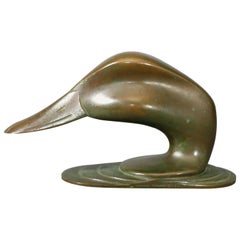Gorham Bronze Duck
Recent Sales
Vintage 1920s American Arts and Crafts Animal Sculptures
Other
A Close Look at Arts-and-crafts Furniture
Emerging in reaction to industrialization and mass production, the Arts and Crafts movement celebrated handcrafted design as a part of daily life. The history of Arts and Crafts furniture has roots in 1860s England with an emphasis on natural motifs and simple flourishes like mosaics and carvings. This work is characterized by plain construction that showcases the hand of the artisan.
The earliest American Arts and Crafts furniture dates back to the start of the 20th century. Designers working in this style in the United States initially looked to ideas put forth by The Craftsman, a magazine published by Wisconsin native Gustav Stickley, a furniture maker and founder of the Craftsman style. Stickley’s furniture was practical and largely free of ornament. His Craftsman style drew on French Art Nouveau as well as the work he encountered on his travels in England. There, the leading designers of the Arts and Crafts movement included William Morris, who revived historical techniques such as embroidery and printed fabrics in his furnishings, and Charles Voysey, whose minimal approach was in contrast to the ornamentation favored in the Victorian era.
American Arts and Crafts work would come to involve a range of influences unified by an elevation of traditional craftsmanship. The furniture was often built from sturdy woods like oak and mahogany while featuring details such as inlaid metal, tooled leather and ceramic tiles. The style in the United States was led by Stickley, whose clean-lined chairs and benches showcased the grain of the wood, and furniture maker Charles Rohlfs, who was informed by international influences like East Asian and French Art Nouveau design.
Hubs in America included several utopian communities such as Rose Valley in Pennsylvania and the Byrdcliffe Arts and Crafts Colony in New York, where craftspeople made furniture that prioritized function over any decoration. Their work would influence designers and architects including Frank Lloyd Wright, who built some of the most elegant and iconic structures in the United States and likewise embraced a thoughtful use of materials in his furniture.
Find antique Arts and Crafts chairs, tables, cabinets and other authentic period furniture on 1stDibs.
Finding the Right Paperweights for You
While any heavy object can be used to hold loose papers, there’s nothing as ornate yet perfectly functional as a paperweight. Antique, new and vintage paperweights can unobtrusively enhance the ambience of a room or act as a colorful conversation starter. On a desk or writing table, it can contribute a subtle sense of style.
Glass paperweights emerged in Europe in the mid-19th century. Early paperweight artisans like Venetian glassmaker Pietro Bigaglia often crafted them with a design on the inside. By the early 1900s, paperweight objects became even more popular through innovative iterations by artists like Louis Comfort Tiffany.
As the paperweight became both a luxury and utilitarian object, creators used a variety of materials to set their wares apart. Today, in addition to the classic glass versions, paperweights are made of metal, wood, ceramic and stone.
A vast selection of paperweights as well as a whole range of other desk accessories can be found on 1stDibs — browse by type, price, period, material or style, from Art Deco and Hollywood Regency to metal and glass. Reflecting their widespread appeal, paperweights are available in a diverse array from across the globe, including Italy, France and North America, as well as examples by leading designers and brands such as Fratelli Toso, William Guillon and René Lalique. Whether an office or a study needs a touch of something vintage or a mid-century modern twist, there are paperweights to suit every taste.
